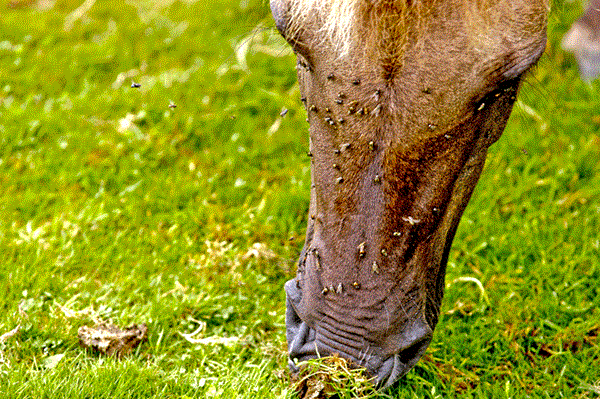 Credit: Thinkstock Most biting flies are attracted to movement, dark surfaces, carbon dioxide and warmth. That’s how they find horses.
Credit: Thinkstock Most biting flies are attracted to movement, dark surfaces, carbon dioxide and warmth. That’s how they find horses.With the heat and humidity of summer come an abundance of bugs, including several types of flies, ticks and stinging pests. Because many insects and their relatives are potential carriers of diseases, horse owners should know which ones are simply nuisances and which could be potentially dangerous to equine health.
“The general warming trend we are experiencing has a big impact on our insect populations,” said Lee Townsend, PhD, and a University of Kentucky College of Agriculture entomologist. “Add moisture to the heat and you have the potential for greater insect problems, so it’s important to review some of the key pests to anticipate.”
The Ubiquitous Fly
Flies are common pests, and while not all flies bite, those who do can make horses nervous, difficult and sometimes dangerous to work around when the horse stomps its feet, kicks and swishes its tail to eliminate insects. Numerous bites can interfere with grazing, and animals can even injure themselves as they run to escape being bitten. Vigorous stamping is another issue, because the repetitive force can cause cracks in hooves and can contribute to shoe loss.
Most biting flies are attracted to movement, dark surfaces, carbon dioxide and warmth. That’s how they find horses.
“Horse flies are sun-lovers and rarely enter barns or shady areas, so grazing animals at night and stabling or providing shelter during the day can provide effective relief,” Townsend said.
House flies are potential carriers of human and animal pathogens and can be a source of irritation to neighbors. House fly maggots occur in moist material, such as manure, garbage, or rotting hay, where development takes seven to 14 days.
Stable flies resemble house flies, but they have a prominent beak that gives a distinctly painful bite. Stable flies usually attack the flank or below the knee, causing horses to stomp their feet and/or kick at their belly. Stable fly maggots develop in decaying organic material, such as a mixture of straw, spilled feed, hay, and water/urine, with a reproductive cycle that takes 21 to 25 days.
Controlling flies is not easy. “There’s no magic solution for fly problems, but recognizing problems early and correcting them if possible will go a long way toward keeping fly numbers manageable,” Townsend said.
Eliminating breeding sites is the key to successful stable fly and house fly control. Clean barns and paddocks once a week to break the life cycle. Spread the removed manure and muck in a thin layer where appropriate, or compost it. Promote good drainage, and look for and fix wet areas around waterers. Insecticides can help reduce house and stable fly populations, but this is a temporary remedy. A good fly management program will ensure that wet and warm organic materials are removed promptly and that thorough drying is encouraged to prevent the proliferation of breeding sites.
Here are Townsend’s suggestions for dealing with flies:
- Use screens in feed and tack rooms and stalls.
- At entryways, install fans that blow down and out to keep flies from entering barns.
- Use insecticides if a problem has developed (this is only a temporary fix, as it does not address the root issue, namely that flies have access to moist breeding material). Carefully follow the manufacturer’s instructions for proper insecticide use.
- Use fly traps and sticky paper to capture flies.
- Consider using a commercial firm that specializes in fly predator release programs.
- Bring horses into barns during the day to give relief.
 Credit: Thinkstock Ticks are blood-sucking relatives of insects that attach to a host (human, horse, dog, etc.) to consume a meal.
Credit: Thinkstock Ticks are blood-sucking relatives of insects that attach to a host (human, horse, dog, etc.) to consume a meal.Ticks
Ticks are blood-sucking relatives of insects that attach to a host (human, horse, dog, etc.) to consume a meal. Some can transmit diseases, including ehrlichiosis, Lyme disease, and piroplasmosis. Severe infestations can cause skin irritations and even anemia.
Ticks can be found in woody areas that have heavy growth and brush, which harbors mice (mice are important hosts). Removing brush to let sunlight in and keeping pastures well-trimmed can make paddocks inhospitable to ticks.
Check with your local county extension agent to determine which species of ticks are most prevalent in your area. In Kentucky, the lone star tick and American dog tick are the most commonly found ticks, and both will attack horses. Remove ticks promptly using tweezers, using a straight pulling motion to ensure removal of the entire tick. Do not twist or squeeze. Also, do not use petroleum jelly, matches or other similar removal methods.
Repellents and insecticides containing permethrin or cypermethrin will provide several hours of protection for horses. These insecticides are very irritating to ticks, so they tend to drop off before attaching to the horse. Check the lower body, especially the legs, and the mane and tail regularly to prevent infestation.
Wasps and Bees
Paper wasps may build open nests under barn eaves and other protected places, said Townsend. It is best to watch for these and destroy them as they are being established in late spring. This reduces the chances for accidental encounters and possible stings in late summer or early fall.
Honey bees occasionally become a problem around water troughs, especially during very dry summers.
“Bees need water to air condition their colonies and will recruit other bees to a reliable source. In some cases, they seem to be aggressive toward horses that are nearby,” Townsend said.


